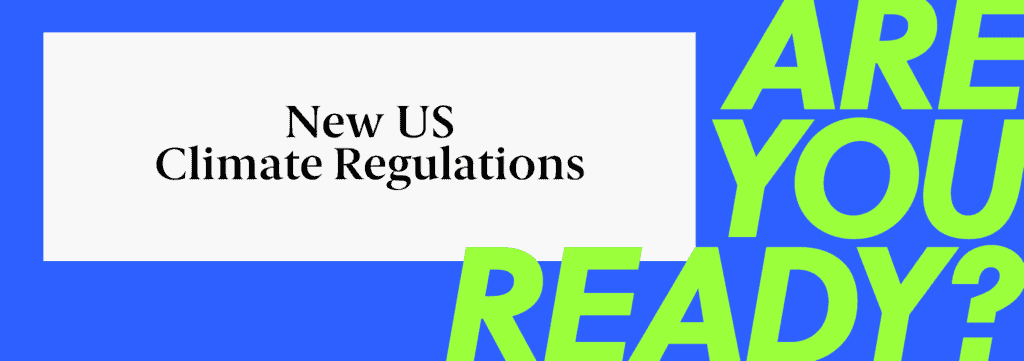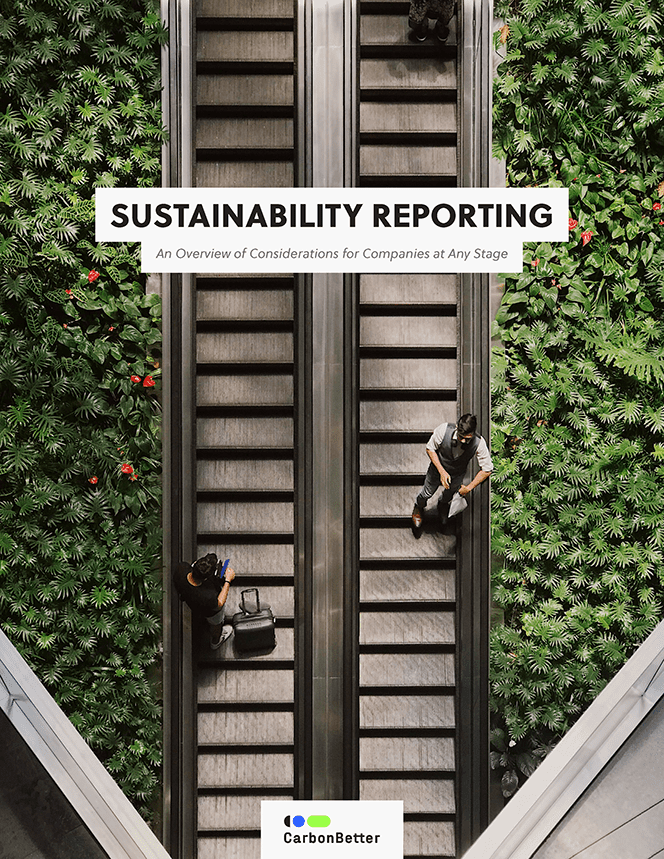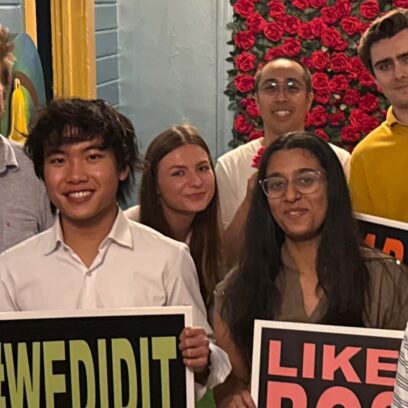Proposed New Emissions Disclosure Requirements to Affect Over 5,000 US Businesses


As climate-related disclosure and mitigation requirements continue to evolve, understanding the latest regulatory landscape is essential for US companies. In this webinar, we cut through the jargon to provide clear insights into emerging climate-related requirements, breaking down two key federal proposals and one EU regulation impacting some US-based companies. Join us to stay informed and prepared for what’s ahead in climate compliance.
The US government has issued a proposed new rule that would require most government suppliers to disclose carbon emissions.
The single largest supplier of goods and services in the world—the United States (US) government, which spends $650 billion with suppliers annually—has issued a proposed new rule that would require government suppliers to disclose carbon emissions, with scope requirements varying by the amount of federal supplier revenue. This new step is part of a plan to achieve net-zero emissions procurement by 2050 under President Biden’s Federal Sustainability Plan. The proposed rule, called the Federal Supplier Climate Risks and Resilience Proposed Rule, would require government suppliers with annual federal contract revenues greater than $7.5 million to disclose Scope 1 and 2 emissions, and suppliers with greater than $50 million in annual federal contract revenue would additionally be required to disclose Scope 3 emissions, assess and disclose risks, and set reduction targets.
This proposed rule covers about 85% of the Federal supply chain, which is estimated to emit more than twice the total emissions of the Federal Government’s 300,000 buildings and 600,000 vehicles combined. The rule will be open for public comment until January 13, 2023.
CarbonBetter helps organizations select and implement the right reporting framework based on their industry and goals. Reach out today to get started.
Explore SolutionsSeparately, the Securities and Exchange Commission (SEC) also has a proposed rule that would require publicly traded companies to disclose their climate-related financial risk and related metrics, including greenhouse gas (GHG) emissions metrics.
While these proposed rules have similar goals of requiring public and standardized disclosures from businesses, the supplier rule requires the use of a CDP Climate Change Questionnaire and the Science Based Targets Initiative (SBTi) criteria to “maximize the consistency, comparability, and accessibility of disclosure data for use in managing Federal procurements and supply chains.” CDP (formerly the Carbon Disclosure Project) is an international non-profit organization that runs a global environmental disclosure system.
What’s Included in the Proposed Supplier Rule
The rule proposes two categories of federal suppliers, as defined by annual federal contract revenue. Larger organizations would have broader scope requirements.
| Segment | Annual Federal Supplier Revenue | Emissions Disclosure Required | Climate-Related Financial Risks Disclosed | Science- Based Targets via SBTi |
|---|---|---|---|---|
| Major Contractors | >$50M | Scope 1, 2, & 3, through CDP | Yes, through CDP | Yes, through SBTi |
| Significant Contractors | >$7.5M, <$50M | Scope 1 & Scope 2 | No | No |
| Other Contractors | <$7.5M | No | No | No |
About the Proposed Requirements
GHG Inventory REQUIREMENTS
Carbon emissions are categorized into three scopes, as referenced in the table above:
- Scope 1—direct GHG emissions from combustion sources owned and controlled by the company
- Scope 2—indirect GHG emissions from purchased energy used by the company
- Scope 3—all other GHG emissions that are a consequence of the activities of the company but are not necessarily controlled by the company itself, including supply chain and corporate travel
Per the proposed rule, GHG inventory requirements would vary based on the company’s federal revenues. Scope 1 and 2 disclosures would be required of significant contractors with annual federal revenues over $7.5 million, and Scope 3 and SBTi targets would be required of major contractors with annual federal revenues over $50 million.
According to information available from the Federal Procurement Data System, “4,413 entities received between $7.5 million and $50 million in Federal contract obligations in FY 2021 (significant), of which 2,835 (64 percent) are estimated to be small businesses. There were approximately 1,353 entities that received more than $50 million in Federal contract obligations in FY 2021 (major contractors), of which 389 (29 percent) are estimated to be small businesses.”
Major contractors that are classified as “small businesses,” as well as nonprofits, may follow significant contractor requirements.
“The single largest supplier of goods and services in the world—the United States (US) government, which spends $650 billion with suppliers annually—has issued a proposed new rule that would require government suppliers to disclose carbon emissions.”
About The PRoposed Federal Rule

SUSTAINABILITY REPORTING OVERVIEW
Sustainability reporting serves as a valuable tool to achieve corporate commitments and better manage climate-related business risks. This white paper walks you through what's typically included and what should be considered.
Annual Climate Disclosure REQUIREMENTS
Major contractors would be required to complete an annual climate disclosure using the CDP Climate Change Questionnaire. This disclosure includes results from the relevant scopes of the completed GHG inventory, as well as the company’s climate risk assessment process and any risks identified. The disclosure must be publicly available on the company’s website or the CDP website.
Science-Based Target Setting REQUIREMENTS
Major contractors would be required to develop science-based targets and have the targets validated by SBTi. These targets must be publicly available on the company’s website or the SBTi website. Once targets are set, contractors will be expected to take action and make progress towards their targets, with progress being reported to SBTi on an annual basis.
When Compliance Would be Required
Federal suppliers will need time to address emissions disclosures and other requirements associated with this proposed rule. Here are the currently proposed timelines:
- Within 1 year of the date of publication, major and significant suppliers (>$7.5 million in federal revenue) will need to disclose total annual Scope 1 and 2 emissions.
- Within 2 years of the date of publication, major suppliers (>$50 million in federal revenue) will also need to disclose Scope 3 emissions, conduct a climate risk assessment and identify risks, complete the CDP Climate Change Questionnaire, and obtain SBTi validation of science-based targets.
Companies that do not follow the new requirements would be deemed “nonresponsible” and ineligible for government supply contracts. There are a few exemptions to this proposed rule, which can be reviewed here.
Ready to start preparing for a potential federal supplier rule? Learn more about steps to take today.
Conclusion
The Federal Supplier Climate Risks and Resilience Proposed Rule marks a potential new era of required disclosure for the world’s largest purchaser of goods and services, the US government, which has the potential to create a global shift in the way business impacts are measured, shared, and improved. The Federal Government has indicated several categories of expected benefits from this proposed regulation:
- Identifying areas for increased efficiency and reduced risks,
- understanding and reduction of supply chain vulnerabilities,
- aligning targets to address climate change,
- improved transparency, accountability, and ability of Federal agencies to collaborate with contractors, and
- increased efficiency of disclosure via standardization.
Once enacted, the timer will start for thousands of federal suppliers that will be required to measure and disclose Scope 1 and 2 carbon emissions within 12 months after the rule is published, with further requirements before the two-year mark for larger suppliers.
The right partner will be critical in meeting these deadlines and limiting risks associated with noncompliance. CarbonBetter helps organizations measure Scope 1, 2, and 3 emissions, supports teams in submitting CDP Climate Change Questionnaires, and helps set and obtain SBTi validation of science-based targets. Reach out today with questions or to get started.
Under the proposed rule, government suppliers with annual federal contract revenues greater than $7.5 million would be required to disclose Scope 1 and 2 carbon emissions, and suppliers with greater than $50 million in annual federal contract revenue would additionally be required to disclose Scope 3 carbon emissions, assess and disclose risks, and set SBTi-approved reduction targets.
The Federal Supplier Climate Risks and Resilience Proposed Rule and the SEC proposed rule to Enhance and Standardize Climate-Related Disclosures for Investors are similar in the requirement to disclose climate-related information, but the requirements and affected businesses are different. The SEC rule is designed to require SEC registrants to disclose "climate-related risks" that are reasonably likely to have a material impact on the business, including GHG emissions. The proposed federal supplier rule would also require GHG disclosure of federal suppliers, with the scope varying based on the volume of annual contracts.
GHG inventory requirements vary based on the company’s federal revenues. Scope 1 and 2 would be required of significant contractors with annual federal revenues over $7.5 million, and Scope 3 and SBTi targets would be required of major contractors with annual federal revenues over $50 million. Based on available data, over 5,000 suppliers would be affected by this new rule.


